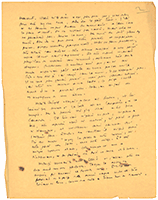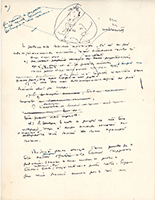22 unique specimens
|
Original watercolor used for the illustration of the Little Prince
This original watercolor painted by Saint-Exupéry on a sheet of Esleeck Fidelity Onion Skin paper to illustrate chapter VI was used for the black and white illustration on page 24 of the original edition. |

|
|
|
Letter to Pierre Dalloz, resistant in Algiers
One of the two last known letters of Antoine de Saint-Exupéry, written a few hours before he disappeared. Captain Rene Gavoille found it on the table of St-Ex's room on the evening of 31 July 1944 when he proceeded to the inventory and then posted the envelope on 3 August 1944. |

|
|
|
Contract for the publication of The Little Prince with Reynal & Hitchcock
Contract in English, printed with typed inserts, related to the publication of The Little Prince, signed on 26 January 1943 in New York between Antoine de Saint Exupery, his American literary agent William Becker and the publisher Reynal & Hitchcock. |

|
|
|
Saint-Exupéry's Alien registration receipt card
In January 1941, Antoine de Saint-Exupéry decided to leave occupied France for good and to settle in New York. Peggy Hitchcock and Elisabeth Reynal, the spouses of his American publishers, joined forces to find him an apartment and to furnish it. They did so on the penultimate floor of a 28 storied building at 240 Central Park South. The rocket-shaped building had just been completed by fashionable architects Albert Mayer and Julian Whittlesey. Writer Maurice Maeterlinck was living on floor 22. Café Arnold -where Saint-Exupéry had his habits- was located on the ground floor. When during a dinner there Eugen Reynal and his wife Elisabeth saw Saint-Exupéry drawing a character on the menu, they suggested him to write a children's story of which the hero would be this little guy. |

|
|
|
Edition of The Little Prince in English autographed by Che Guevarra
PP-3939 (first edition, fifth printing) has two inscriptions. The first is from 1947. The second is dated from 4 September 1959 at the end of the Cuban revolution. This inscription is from Che Guevara for his friend Pancho Gamin and it reads:"A través de tantos años de lucha, a mi amigo Pancho Gamin" ("To my friend Pancho Gamin, after so many years of fighting"). |

|
|
|
Original edition of The Little Prince in French inscribed by Consuelo de Saint Exupéry
PP-1180 (first edition in France, copy nr. 7190) autographed by Consuelo de Saint Exupery: Paul, I'm always running. But the drafts in your world scare me. If a rose starts running, it loses all its petals ... But, as you love The Little Prince, you will give me protection. in Valencia (A gardener's dream) Consuelo de Saint Exupery 5 December 1947 |

|
|
|
French edition of The Little Prince inscribed by Consuelo de Saint Exupéry
PP-5673 (copy published by Gallimard on 12 October 1964) autographed by Consuelo de Saint Exupery: A madame Henri Murer de La Plagne Janette mon amie : vous êtes la fleur unique d'Henri et vous savez bien qu'il est un Petit Prince : Le Vôtre. Et que c'est vous, votre charme votre vie qui le retiens sur notre planète. Et moi j'aime aussi votre parfum, votre courage. Je vous embrasse. Consuelo Comtesse Antoine de Saint Exupéry. |

|
|
|
French edition of The Little Prince inscribed by Consuelo de Saint Exupéry
PP-5858 (copy published by Gallimard in 1977) dedicated by Consuelo to Préfet Roger Benmebarek: "In memory of my husband, with all my friendly sympathy, Countess de Saint Exupéry, Paris 10-2-78" "Mister Roger Benmebarek, Good morning says the Little Prince, very happy that he is kind to his flower... he send you a kiss" |

|
|
|
First print run of the first edition of Southern Mail, autographed by Antoine de Saint-Exupery
OW-113, original edition of Southern Mail, press service copy, with a superb and long autograph signed to Henri Guillaumet: "To Guillaumet, to whom I would like to write the most beautiful of dedications because he is the best of my friends. Because a long time ago I adopted him as a brother - After being his humble pupil... (Do you remember, Guillaumet, the advice you gave me one evening in your room, the day before my first mail flight? I was a studious pupil, from time to time there was recreation and you made me drink port wine. I also remember a rum that cost thirty-four francs a liter... Of which I drank everything!). Your old friend" |

|
|
|
Autograph manuscript with 2 drawings
One page (28 x 21,5 cm) on American watermarked Fidelity Onion Skin paper. Draft of about twenty lines, extensively crossed out and corrected, related to the project of Le Caïd which will become Citadelle, probably written in New York in 1942. "Standing on the highest tower, applying my two hands, as if on a railing, to the thick stone table, I considered my empire”. At the top of the page, in pen, a head of The Little Prince; bottom of the page, drawing of The Little Prince standing; traces of watercolor. Exhibited in the exhib Exhibited in the exhibition "À la rencontre du Petit Prince" (Musée des Arts décoratifs, 2022) Catalog p. 198 |

|
|
|
Unpublished manuscript about anxiety
The pilot often evokes, in his correspondence with Nelly de Vogüé, Consuelo or Lewis Galantière, anxiety attacks, usually manifested during his American stays, which paralyze him intellectually. The detailed analysis he makes here of his various anxiety attacks has almost a therapeutic value: writing becomes clinical. |

|
|
|
Manuscript of the first chapter of the Letter to a hostage, "A real symphonic poem" (F. Gerbod)
This manuscript presents a more detailed version than the one finally published (Complete works, Tome II, [PP-2622] Bibliothèque de la Pléiade, 2009, p. 89-92). This new version is an important complement to the one kept at the Smithsonian Institution, in Washington. Especially since the known manuscripts and typoscripts from this first chapter are not very refined. After Portugal, several pages depict New York, where Saint-Exupéry is absorbed by the writing of Night Flight, but far from his homeland and his family. The noise of the city is pervasive and prevents him from writing. |

|
|
|
Manuscript of an essay on television. USA, ca. 1940
Interesting draft of an unpublished essay by Saint-Exupéry who had filed patents on electromagnetic waves. The essay not only theorises the television licence fee, but also gives technical means of limiting broadcasts against viewers who have not paid it. Autograph manuscript with numerous erasures and corrections and technical sketches. At the top of the first page is a drawing of a small character resembling The Little Prince). "The problem of commercial television, which is in fact that of financing the programmes, would be entirely resolved if each user paid a fee for each show he or she attended, proportional to the duration and quality of the show, without any possibility of fraud. " "The control of such patents: the locking of the image (by sufficiently coarse disturbances so that the unlocking current can be transmitted by wire) and the unlocking of this image by the current coming from a wire ensures the control of the broadcasts since the locked broadcasts will be the only ones paying" (chap. XIX). |

|
|
|
Manuscript of the scientific text The wind and its measurement Brest, 1929
Important scientific manuscript, illustrated with numerous sketches and geometric figures. In it, Saint-Exupéry gives an in-depth study of the wind, its measurement and its implication in the piloting of an aircraft. In 1929, the Latécoère company (later Aéropostale) sent Saint-Exupéry to Brest to attend the Navy's advanced air navigation course, given by the young lieutenant Lionel-Max Chassin. Chassin recalled that his pupil "quickly distinguished himself by his absent-mindedness and his keen intelligence. As much as he was sometimes brilliant in theory, in the practical exercises that we carried out every day he was clumsy, awkward and, to put it bluntly, bad ". Perhaps Saint-Exupéry was too preoccupied with the correction of the proofs of Southern Mail to be fully engaged in his studies. |

|
|
|
Drawing on paper
Drawing on paper, head of a man smoking with text: "This is not the Little Prince..." and signature of Antoine de Saint Exupéry. |

|
|
|
Study of a woman's head with The Little Prince
Drawing on paper, study of a woman's head with The Little Prince and stars, and on the right the text: "For Janine Mangin these evocations of a somewhat dilapidated human species seen at the Belvedere casino. In the hope of a future planet whose inhabitants would be more gracious With my friendship Antoine de Saint Exupéry N.B. Of course, my review is neither about her nor about me. |

|
|
|
Studies of the heads of men and women
Ten sheets with four studies of male and female heads on each sheet |

|
|
|
Envelope with handwritten text
Envelope "Residence of the French Republic in Tunis" with handwritten text on the back: "When this animal is well drawn it looks like a rabbit. I came at 5:28. I waited walking up and down until 6 o'clock (the bistro was closed). At six o'clock I thought maybe you had come by before 5.28 and having found the bistro closed, had change.” |

|
|
|
A self-portrait of Saint Exupéry
Double-sided leaflet with drawings and aerodynamic calculations, but above all with a self-portrait of Saint-Exupéry. |

|
|
|
Study of head with hat
Study of head with hat from the newspaper Tunisie Libérée of 11 August 1943 |

|
|
|
Typescript of an early German translation
Typescript of a German translation of The Little Prince by Monika Mayr, an Austrian psychoanalyst (1922-1983). This typescript, dating from around 1950, came from the estate of Ignaz Zangerle, a well-known writer and adult educator in Innsbruck. His daughter Veronika Zangerle (Pointer-Zangerle by marriage in Salzburg) sold it to a Viennese collector. The illustrations are attributed to the Tyrolean painter Max Weiler, who painted the portrait of the Zangerle couple, among other things. |

|
|
|
Typescript of July 1943 signed by Saint Exupéry
Letter written in La Marsa, near Tunis, in July 1943. First published in Le Figaro littéraire no. 103 on April 10, 1948, News-99 and published in 1956 by Gallimard in the book "Un sens à la Vie". |

|
|

